Today is the final day of Le Giornate del Cinema Muto 2019. The Silent Film Festival in Pordenone closes with the classic Hitchcock thriller The Lodger (1927). So in its last Pordenone post, EFSP features the star of the film, gorgeous matinee idol Ivor Novello (1893-1951). The 'Valentino from The Valleys' was one multi-talents of the British stage and cinema during the first half of the 20th century. On stage, the 'British Sex God in tight pants' produced and composed a string of hit musicals, starring himself. He also appeared in several successful silent and early sound films in France, Great-Britain and Hollywood.

British Postcard in the Celebrities Series, no. 137, printed by Associated Photo Printers, London by courtesy of W & F Film Service.
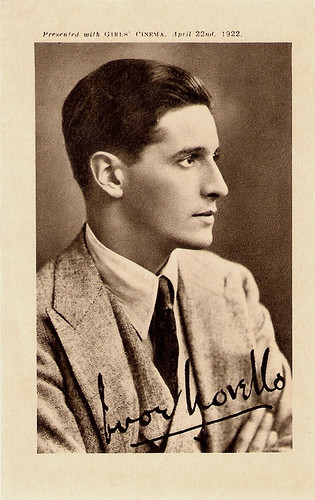
British postcard, presented with Girl's Cinema, 1922.

British Postcard in the Picturegoer Series, London, no. 82. Photo: Foulsham & Banfield.

British postcard in the Picturegoer series by Real Photograph, London.

British postcard in the Picturegoer series, London, no. 194.
Ivor Novello was born as David Ivor Davies at Llwyn-yr-Eos, Wales in 1893, to the well-known singing teacher and choral conductor Clara Novello Davies and David Davies, rent collector for the city council. The family then went to live in Cardiff, where his mother taught the Welsh Ladies Choir.
As a boy, Novello was a successful singer in Welsh Eisteddfod. He then attended the Magdalen College School in Oxford, where he sang in the famous choir. The good-looking boy made his first public appearances as a pub and working men's club pianist and singer in and around the Cardiff area.
Novello also showed a facility for writing songs, and when he was only 15, one of his songs was published. After leaving school, he gave piano lessons in Cardiff, and then moved to London in 1913. He took a flat above the Strand Theatre, which became his London home for the rest of his life.
At the start of the First World War, Novello wrote Keep the Home Fires Burning, a song that expressed the feelings of innumerable families sundered by World War I. Novello composed the music for the song to a lyric by the American Lena Guilbert-Ford. It became a real World War I standard, and earned him £15,000.
In 1916 Ivor received a commission as a Sub-Lieutenant and trained as a pilot in the Royal Naval Air Service. He completed dual flying instruction but crash landed on his first solo. His second solo flight ended in a more serious crash, in which he injured his ankle. The Royal Navy grounded him, and he was posted to clerical duties for the duration of the war.
While he was in the Navy, he worked for the show Theodore & Co (1916). It was a production by George Grossmith, Jr. and Edward Laurillard with a score composed by Novello and the young Jerome Kern. Again, it was a hit and, these successes made David Ivor Davies an overnight celebrity.
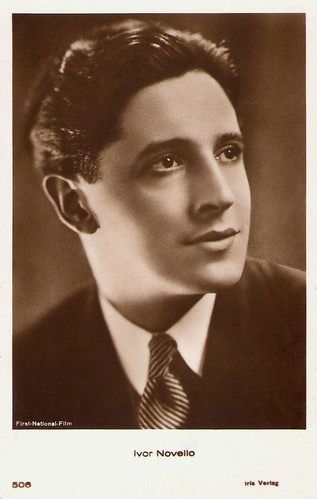
Austrian postcard by Iris Verlag, no. 506. Photo: First National Film.
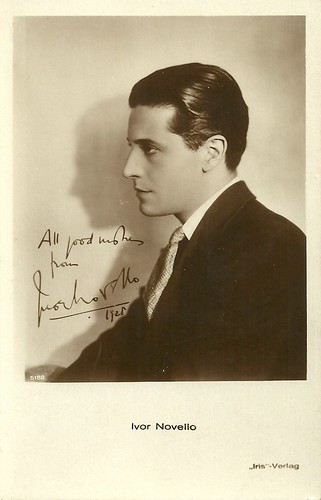
Austrian postcard by Iris Verlag, no. 5188. Dedication: "All good wishes from Ivor Novello, 1928."

British Postcard, no. 4.

British postcard, no. 3865/1. Photo: FPS. At the backside: Real Hand-coloured Photograph.
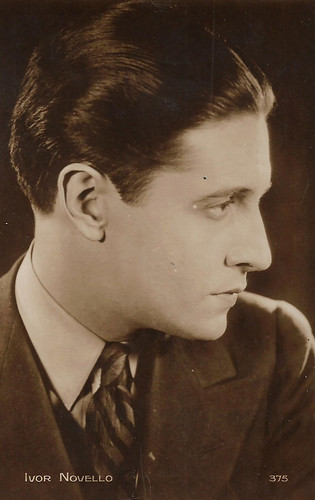
French postcard by Editions Cinémagazine, no. 375.
David Ivor Davies legally changed his name to Ivor Novello in January 1927, although he was known by that name on stage from at least 1918. After the First World War he pursued a film acting career and debuted as the romantic lead in L'appel du sang/The Call of the Blood (Louis Mercanton, 1919).
This French romantic melodrama starring Gabriel de Gravone was a box office success and earned Novello the sobriquet the 'Valentino from The Valleys'.
It was followed by roles in such films as the French drama Miarka, la fille à l'ourse/Gypsy Passion (Louis Mercanton, 1921) featuring Desdemona Mazza, the British drama Carnival (Harley Knoles, 1921) with Matheson Lang, and the romance The Bohemian Girl (Harley Knoles, 1922) with Gladys Cooper.
In 1923, he made his American movie debut in D. W. Griffith's The White Rose. His classic profile made Novello a matinee idol among filmgoers. On stage, he occasionally played dramatic roles, such as the title role in the first London production of Ferenc Molnar's Liliom, the Hungarian play from which the American musical Carousel was later adapted.
In 1924 Novello wrote and appeared in his first play, the successful The Rat which transferred quite well to film the following year. This film adaptation, The Rat (Graham Cutts, 1925) inspired two sequels - The Triumph of the Rat (Graham Cutts, 1926) and The Return of the Rat (Graham Cutts, 1929), both with Isabel Jeans.

British postcard in the Famous Oldies series by Collectorcard, Croydon, no. C9005. Photo: The National Film Archive. Gladys Cooper and Ivor Novello in The Bohemian Girl (Harley Knoles, 1922).

British Postcard in the Picturegoer Series, London, no. 39A. Photo: Ivor Novello in The Rat (Graham Cutts, 1925).

British postcard by A Real Photograph in the Film Partners series, no. P 41. Photo: Stanborough. Ivor Novello and Elizabeth Allan in the sound version of The Lodger (1932).
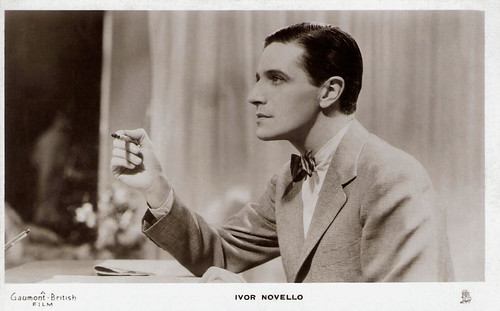
British postcard by Raphael Tuck & Sons, London, no. 50-S. Photo: Gaumont-British. Still for Love and Let Love/Sleeping Car (Anatole Litvak, 1933).

British Postcard by Beagles, no. 313.R. Photo: Francis Bruguiere.
Ivo Novello peaked as a film star when he was the lead of two of Alfred Hitchcock's early suspense thrillers. He convincingly portrayed the brooding, sinister suspected serial killer in the silent classic The Lodger (Alfred Hitchcock, 1927). That year he also was the protagonist in the lesser-received Downhill (Alfred Hitchcock, 1927) with Isabel Jeans.
In 1928 Novello starred in the silent adaptation of Noel Coward's successful play The Vortex (Adrian Brunel, 1928), and made his last silent film, the comedy A South Sea Bubble (T. Hayes Hunter, 1928) with Benita Hume and Alma Taylor.
Novello's dark, handsome looks belied a charming modesty. He had a fine, well-modulated speaking voice that transferred quite well to talkies. After the introduction of sound film, he wrote and starred in Symphony in Two Flats (Gareth Gundrey, 1930) and remade The Lodger (Maurice Elvey, 1932) with Elizabeth Allan as his co-star.
During this time he surprisingly wrote the dialogue for Tarzan the Ape Man (W.S. Van Dyke, 1932), the first film to star Johnny Weissmuller and Maureen O'Sullivan. After his last film Autumn Crocus (Basil Dean, 1934), he decided to devote himself full time to music and the theatre.
He earned rave reviews for his opulent, romantically melodramatic stagings of Glamorous Night (1935), The Dancing Years (1939) and Perchance to Dream (1945). During his career he wrote eight musicals and appeared in six of them, all non-singing parts. Novello wrote his musicals in the style of operetta and was one of the last major composers in this form. He generally composed his music to the librettos of Christopher Hassall.
Although adored by thousands of women, Novello was gay. In 1916 he met the then 21-year-old actor Bobby Andrews. The pair became friends, then lovers, and stayed together for 35 years. They performed together many times in Novello's musicals and plays. In 1921, Novello also had an affair with the British poet and writer Siegfried Sassoon. Sassoon's biographer, John Stuart Roberts later wrote that Novello "was a consummate flirt who collected lovers as he gathered lilacs."
During most of his life, Novello lived in a country house in Littlewick Green, which he had bought from his film earnings. In 1951, Ivor Novello suddenly died from a coronary thrombosis in London at the age of 58. 7,000 people attended his funeral (women outnumbered men 50 to one).
Since the 1950s, the annual awards of the Performing Rights Society are named in his honour. In 2001, Jeremy Northam played Novello in Gosford Park (Robert Altman, 2001).

British postcard in the Picturegoer series by Real Photograph, London, no. 82a.
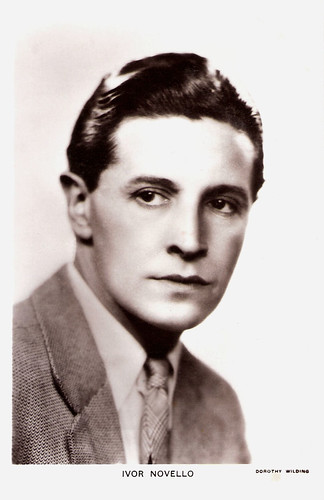
British postcard in the Picturegoer series by Real Photograph, London, no. 39c. Photo: Dorothy Wilding.
Short Apache Dance from The Rat (1925). Source: Jrrzyboy (YouTube).
Trailer for The Lodger (1927). Source: Chuy Espinosa (YouTube).
Ivor Novello in the mob scene of The Lodger (1927). Source: Karloff4 (YouTube).
Sources: Anthony Slide (Encyclopedia of British Cinema), Gary Brumburgh (IMDb), BBC Wales, Wikipedia and IMDb.

British Postcard in the Celebrities Series, no. 137, printed by Associated Photo Printers, London by courtesy of W & F Film Service.

British postcard, presented with Girl's Cinema, 1922.

British Postcard in the Picturegoer Series, London, no. 82. Photo: Foulsham & Banfield.

British postcard in the Picturegoer series by Real Photograph, London.

British postcard in the Picturegoer series, London, no. 194.
Crashes
Ivor Novello was born as David Ivor Davies at Llwyn-yr-Eos, Wales in 1893, to the well-known singing teacher and choral conductor Clara Novello Davies and David Davies, rent collector for the city council. The family then went to live in Cardiff, where his mother taught the Welsh Ladies Choir.
As a boy, Novello was a successful singer in Welsh Eisteddfod. He then attended the Magdalen College School in Oxford, where he sang in the famous choir. The good-looking boy made his first public appearances as a pub and working men's club pianist and singer in and around the Cardiff area.
Novello also showed a facility for writing songs, and when he was only 15, one of his songs was published. After leaving school, he gave piano lessons in Cardiff, and then moved to London in 1913. He took a flat above the Strand Theatre, which became his London home for the rest of his life.
At the start of the First World War, Novello wrote Keep the Home Fires Burning, a song that expressed the feelings of innumerable families sundered by World War I. Novello composed the music for the song to a lyric by the American Lena Guilbert-Ford. It became a real World War I standard, and earned him £15,000.
In 1916 Ivor received a commission as a Sub-Lieutenant and trained as a pilot in the Royal Naval Air Service. He completed dual flying instruction but crash landed on his first solo. His second solo flight ended in a more serious crash, in which he injured his ankle. The Royal Navy grounded him, and he was posted to clerical duties for the duration of the war.
While he was in the Navy, he worked for the show Theodore & Co (1916). It was a production by George Grossmith, Jr. and Edward Laurillard with a score composed by Novello and the young Jerome Kern. Again, it was a hit and, these successes made David Ivor Davies an overnight celebrity.

Austrian postcard by Iris Verlag, no. 506. Photo: First National Film.

Austrian postcard by Iris Verlag, no. 5188. Dedication: "All good wishes from Ivor Novello, 1928."

British Postcard, no. 4.

British postcard, no. 3865/1. Photo: FPS. At the backside: Real Hand-coloured Photograph.

French postcard by Editions Cinémagazine, no. 375.
Home Fires
David Ivor Davies legally changed his name to Ivor Novello in January 1927, although he was known by that name on stage from at least 1918. After the First World War he pursued a film acting career and debuted as the romantic lead in L'appel du sang/The Call of the Blood (Louis Mercanton, 1919).
This French romantic melodrama starring Gabriel de Gravone was a box office success and earned Novello the sobriquet the 'Valentino from The Valleys'.
It was followed by roles in such films as the French drama Miarka, la fille à l'ourse/Gypsy Passion (Louis Mercanton, 1921) featuring Desdemona Mazza, the British drama Carnival (Harley Knoles, 1921) with Matheson Lang, and the romance The Bohemian Girl (Harley Knoles, 1922) with Gladys Cooper.
In 1923, he made his American movie debut in D. W. Griffith's The White Rose. His classic profile made Novello a matinee idol among filmgoers. On stage, he occasionally played dramatic roles, such as the title role in the first London production of Ferenc Molnar's Liliom, the Hungarian play from which the American musical Carousel was later adapted.
In 1924 Novello wrote and appeared in his first play, the successful The Rat which transferred quite well to film the following year. This film adaptation, The Rat (Graham Cutts, 1925) inspired two sequels - The Triumph of the Rat (Graham Cutts, 1926) and The Return of the Rat (Graham Cutts, 1929), both with Isabel Jeans.

British postcard in the Famous Oldies series by Collectorcard, Croydon, no. C9005. Photo: The National Film Archive. Gladys Cooper and Ivor Novello in The Bohemian Girl (Harley Knoles, 1922).

British Postcard in the Picturegoer Series, London, no. 39A. Photo: Ivor Novello in The Rat (Graham Cutts, 1925).

British postcard by A Real Photograph in the Film Partners series, no. P 41. Photo: Stanborough. Ivor Novello and Elizabeth Allan in the sound version of The Lodger (1932).

British postcard by Raphael Tuck & Sons, London, no. 50-S. Photo: Gaumont-British. Still for Love and Let Love/Sleeping Car (Anatole Litvak, 1933).

British Postcard by Beagles, no. 313.R. Photo: Francis Bruguiere.
Hitchcock
Ivo Novello peaked as a film star when he was the lead of two of Alfred Hitchcock's early suspense thrillers. He convincingly portrayed the brooding, sinister suspected serial killer in the silent classic The Lodger (Alfred Hitchcock, 1927). That year he also was the protagonist in the lesser-received Downhill (Alfred Hitchcock, 1927) with Isabel Jeans.
In 1928 Novello starred in the silent adaptation of Noel Coward's successful play The Vortex (Adrian Brunel, 1928), and made his last silent film, the comedy A South Sea Bubble (T. Hayes Hunter, 1928) with Benita Hume and Alma Taylor.
Novello's dark, handsome looks belied a charming modesty. He had a fine, well-modulated speaking voice that transferred quite well to talkies. After the introduction of sound film, he wrote and starred in Symphony in Two Flats (Gareth Gundrey, 1930) and remade The Lodger (Maurice Elvey, 1932) with Elizabeth Allan as his co-star.
During this time he surprisingly wrote the dialogue for Tarzan the Ape Man (W.S. Van Dyke, 1932), the first film to star Johnny Weissmuller and Maureen O'Sullivan. After his last film Autumn Crocus (Basil Dean, 1934), he decided to devote himself full time to music and the theatre.
He earned rave reviews for his opulent, romantically melodramatic stagings of Glamorous Night (1935), The Dancing Years (1939) and Perchance to Dream (1945). During his career he wrote eight musicals and appeared in six of them, all non-singing parts. Novello wrote his musicals in the style of operetta and was one of the last major composers in this form. He generally composed his music to the librettos of Christopher Hassall.
Although adored by thousands of women, Novello was gay. In 1916 he met the then 21-year-old actor Bobby Andrews. The pair became friends, then lovers, and stayed together for 35 years. They performed together many times in Novello's musicals and plays. In 1921, Novello also had an affair with the British poet and writer Siegfried Sassoon. Sassoon's biographer, John Stuart Roberts later wrote that Novello "was a consummate flirt who collected lovers as he gathered lilacs."
During most of his life, Novello lived in a country house in Littlewick Green, which he had bought from his film earnings. In 1951, Ivor Novello suddenly died from a coronary thrombosis in London at the age of 58. 7,000 people attended his funeral (women outnumbered men 50 to one).
Since the 1950s, the annual awards of the Performing Rights Society are named in his honour. In 2001, Jeremy Northam played Novello in Gosford Park (Robert Altman, 2001).

British postcard in the Picturegoer series by Real Photograph, London, no. 82a.

British postcard in the Picturegoer series by Real Photograph, London, no. 39c. Photo: Dorothy Wilding.
Short Apache Dance from The Rat (1925). Source: Jrrzyboy (YouTube).
Trailer for The Lodger (1927). Source: Chuy Espinosa (YouTube).
Ivor Novello in the mob scene of The Lodger (1927). Source: Karloff4 (YouTube).
Sources: Anthony Slide (Encyclopedia of British Cinema), Gary Brumburgh (IMDb), BBC Wales, Wikipedia and IMDb.
No comments:
Post a Comment